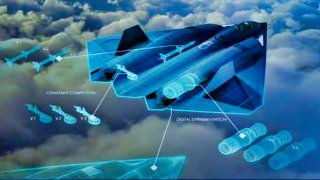X-44 MANTA, Explained
The X-44 MANTA was a top-secret late 1990s experimental aircraft design, considered at a time when America had the latitude and the capacity to experiment widely.
The X-44 MANTA was a top-secret late 1990s experimental aircraft design, considered at a time when America had the latitude and the capacity to experiment widely.
A Different Time
In the late 1990s, the United States was unrivaled. The Soviet Union had collapsed. China was yet to ascend. Osama bin Laden had yet to shatter America’s conception of domestic invulnerability. Housing and dot com bubbles, which would later burst, held firm. And American military technology was far and away the most advanced in the world.
With respect to military technology, the Americans held several key advantages. Supercarriers. A stockpile of nuclear weapons and intercontinental ballistic missiles capable of delivering those weapons with pinpoint accuracy around the world. A fleet of nuclear-powered submarines. The world’s only stealth bomber.
And the world’s only fifth-generation fighter aircraft, the F-22.
The X-44 was developed from the F-22 – proposing to take the F-22’s class-leading stealth characteristics and enhance them. How? By removing flight surfaces increased the F-22’s radar cross section (RCS).
Note: the MANTA designation is an acronym standing for Multi-Axis No-Tail Aircraft.
The removal of flight surfaces would also serve to reduce drag, hence increasing the jet’s speed and fuel efficiency. The design did have a drawback, however: it’s the flight surfaces that are what facilitate an aircraft to maneuver: to yaw, pitch, and roll. Could an F-22 without many of the flight surfaces needed to fly be able to fly?
Never Getting Off the Ground
Not surprisingly, the tail-less variant of the F-22 never got off the ground. That’s not to say that the X-44 would not have been capable of flying, the program did get as far as scheduling a test flight, sometime in 2007, but the program was canceled in 2004, before that flight would ever occur. The program was canceled before anything was ever even manufactured; the X-44 never got further along in the production process than a handful of blueprint drawings.
Still, some of the ideas associated with the X-44 design have come to light. “A patent dated 1996 and belonging to Lockheed has been identified as the real X-44A’s design, or at least very close to it,” The War Zone reported. ‘The X-44’s skin is supposedly made out of nano-carbon fiber and it’s powered by a Williams F112 turbojet engine.”
The X-44 would have relied upon thrust vectoring to compensate for the lack of flight surfaces. Thrust vectoring, a system in which the aircraft’s exhaust nozzle can be adjusted to blow exhaust at different angles and enhance an aircraft’s maneuverability, has proven successful in jets like the F-22 and the F-35. But thrust vectoring has, to date, been used as a supplement to enhance maneuverability rather than the primary method of maneuvering.
The top-secret nature of the X-44 leads us to wonder what else the Pentagon has considered behind closed doors.
Harrison Kass is a defense and national security writer with over 1,000 total pieces on issues involving global affairs. An attorney, pilot, guitarist, and minor pro hockey player, Harrison joined the US Air Force as a Pilot Trainee but was medically discharged. Harrison holds a BA from Lake Forest College, a JD from the University of Oregon, and an MA from New York University. Harrison listens to Dokken.
Image Credit: Creative Commons and/or Shutterstock.

